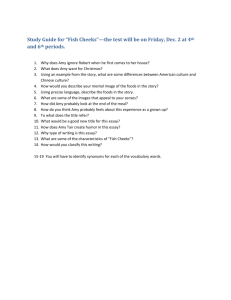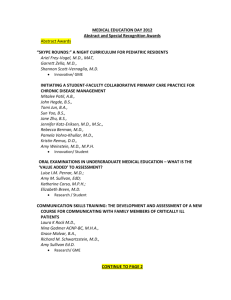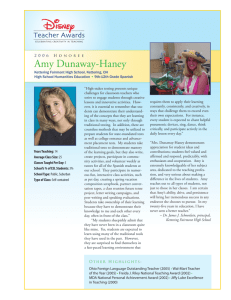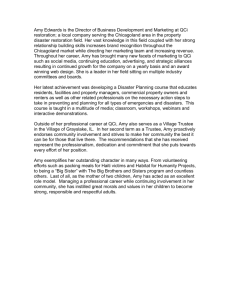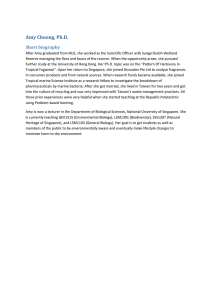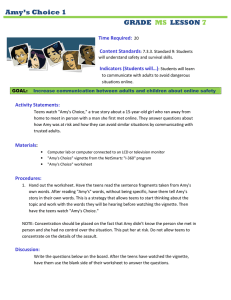Amy’s Choice GRADE LESSON
advertisement
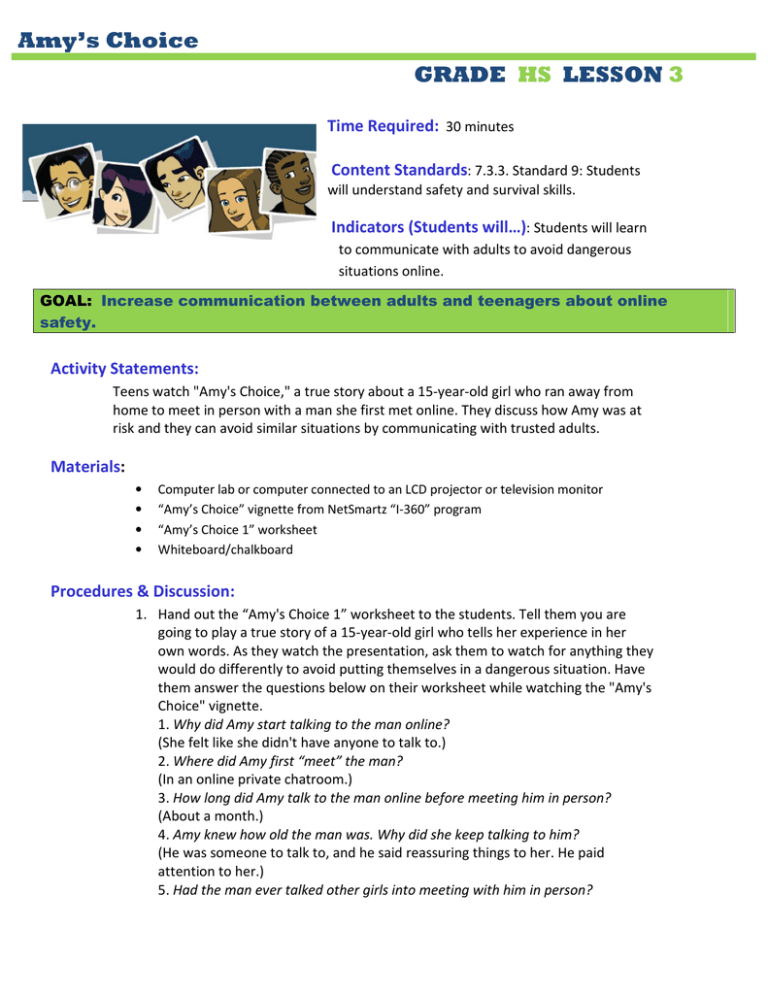
Amy’s Choice GRADE HS LESSON 3 Time Required: 30 minutes Content Standards: 7.3.3. Standard 9: Students will understand safety and survival skills. Indicators (Students will…): Students will learn to communicate with adults to avoid dangerous situations online. GOAL: Increase communication between adults and teenagers about online safety. Activity Statements: Teens watch "Amy's Choice," a true story about a 15-year-old girl who ran away from home to meet in person with a man she first met online. They discuss how Amy was at risk and they can avoid similar situations by communicating with trusted adults. Materials: • • • • Computer lab or computer connected to an LCD projector or television monitor “Amy’s Choice” vignette from NetSmartz “I-360” program “Amy’s Choice 1” worksheet Whiteboard/chalkboard Procedures & Discussion: 1. Hand out the “Amy's Choice 1” worksheet to the students. Tell them you are going to play a true story of a 15-year-old girl who tells her experience in her own words. As they watch the presentation, ask them to watch for anything they would do differently to avoid putting themselves in a dangerous situation. Have them answer the questions below on their worksheet while watching the "Amy's Choice" vignette. 1. Why did Amy start talking to the man online? (She felt like she didn't have anyone to talk to.) 2. Where did Amy first “meet” the man? (In an online private chatroom.) 3. How long did Amy talk to the man online before meeting him in person? (About a month.) 4. Amy knew how old the man was. Why did she keep talking to him? (He was someone to talk to, and he said reassuring things to her. He paid attention to her.) 5. Had the man ever talked other girls into meeting with him in person? Amy’s Choice GRADE HS LESSON 3 (Yes, but he'd never been caught.) 6. Why is Amy still worried? (The man still knows where she lives and could call or try to visit her after getting out of jail.) 7. Why does Amy encourage other teens to talk to their parents about what's going on even though they might get in trouble? (You never know what a person you are talking to online may be capable of doing. It is always good to get help from a trusted adult.) 2. After watching "Amy's Choice," quickly go over the questions as a class, having students fill in any answers they may have missed. 3. Split the students into groups of three or four teens. Write the questions below on the board. Have them answer the questions in their groups and then invite several groups to share some of their responses with the class. 1. Why aren't many teens concerned about giving out personal information online? 2. At what point do you think Amy regretted sharing her personal information? 3. What were the consequences of sharing her personal information online? 4. If your friend confides in you that he or she is thinking about meeting in person with anyone he or she first “met” online, what would you tell him or her? (Show the friend "Amy's Choice" or other materials from the NetSmartz "I-360" program. Find stories from reputable news sites to tell your friend about other young people who had face-to-face encounters with someone they first “met” on the Internet. Make sure your friend realizes that he or she could be putting him – or herself in danger and not even know it.) 4. Explain to the students that Amy felt like she didn't have many friends and was struggling with problems at home. Amy knew this man was an adult, but since chatting was "anonymous," she didn't think anything would ever come of it. She turned to this man for "help," but not only was the "help" not there, she opened herself up to possible exploitation. 5. Many teens struggle with similar feelings about friends and problems at home. If you had a friend who felt this way, who could you or that friend turn to for help? (Family member, school counselor, community center, religious/spiritual advisor, teacher. You may want to list these on the board.) What other ways could Amy have dealt with her problems besides turning to a chatroom for support? You may wish to suggest some community resources to the teens in case they, or someone they know, struggle with tough choices. (These can be found in the “Additional Resources” below). This may also be a good opportunity for a school counselor to visit the class. Amy’s Choice GRADE HS LESSON 3 Additional Resources: www.NetSmartz.org Some resources* include: Teen Crisis Hotline: 800.852.8336 National Runaway Switchboard: 800.621.4000 Covenant House 9 Line: 800.999.9999 *Please note that we provide this list as a public service. The National Center for Missing & Exploited Children does not sponsor or endorse any organization listed.

